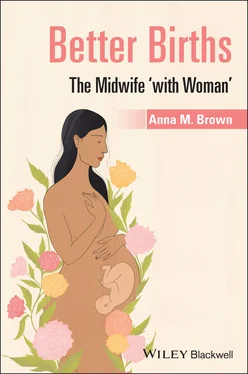Processing Midwifery Knowledge and Skills
A ‘with woman’ concept demands antecedents of sound midwifery knowledge and competent skills. The integrative review by Bradfield et al. (2018a,b) of this concept has identified the attribute of a dynamic developing process of this construct. The authors suggest a transference of power to the woman through effective informed decision making and facilitation of ‘space’ by the midwife that enables this process (Dolin 2017). However, much of the literature that explores related concepts, such as ‘women centred care’, can have a wide variation in how this is interpreted. Leap (2009) suggests that whilst contesting meanings of the term, the focus should be on shifting the locus of control to the woman, in meeting her individual needs through safe, supportive and gentle care.
The phenomenological study by Bradfield et al. (2019b) indicates that midwives consider the ‘with woman’ phenomenon as an essential element to the practice and identity of their profession. Midwifery knowledge and experience informs their skills underpinned by a ‘with woman’ philosophy that defines and identifies them as experts in their field. Being ‘with woman’ in contemporary midwifery as best practice needs to be recognised, maintained and disseminated to future generations of midwives (Power et al. 2016). In addition, maintaining a therapeutic partnership with women and their families requires advanced, effective communication skills to provide advocacy for women with knowledge and confidence (Bradfield et al. 2019a, Bradfield et al. 2019b). The mother and midwife relationship through continuity of care provides midwives with greater flexibility and responsibility, leading to improved maternal satisfaction (Astrup 2016).
Physical Wellbeing Through Environmental Factors
The interpretation of continuous support during labour has changed over time. Women have been cared for and supported physically and psychologically, across the ages, by other women during childbirth. Changes in models of care during labour have impacted the way women are supported during this life‐changing event. Consequently, a rise in hospital births in the post‐war era has medicalised childbirth and interrupted the relationship of midwives with women in the home environment. However, a move towards provision of continuity of support in labour, by midwives as ‘ritual companions’, over the last few decades, has had an impact on birth outcomes (Reed et al. 2016). Physical, psychological and spiritual support has resulted in a reduced risk of caesarean section, instrumental delivery and need for analgesia (McDonald 2011).
Innovations such as birthing pools, improved equipment and alternative therapies for pain relief used in labour have changed midwifery practices to ameliorate the birthing environment. However, organisational factors such as rising costs, shortage of staff and resources have had an impact on the provision and quality of maternity services. Over time, these have collectively had a significant bearing on women's satisfaction with their childbirth experiences and have ‘cost’ midwives and healthcare professionals in terms of their health and wellbeing (Leinweber and Rowe 2010; Amir and Reid 2018).
The new standards for the midwifery profession (NMC 2019, p. 16) state that a midwife must ‘ Provide safe and effective midwifery care: promoting and providing continuity of care and carer’ . It is unclear how midwives will be able to fulfil the expectation of continuity of carer when the midwifery workforce is depleted to a risk level that needs addressing urgently. Consequently, midwives are suffering from occupational burnout, experiencing stress and anxiety and need organisational and peer/colleague support (Yoshida and Sandall 2013). The Department of Health has recognised these shortfalls and currently changes are in progress. There is a move to improve and balance life/work conditions (Knapp 2017a) and change to bursaries for students entering the profession as a way forward for those who struggle, at personal cost, to provide safe and effective midwifery care.
This chapter has examined the literature that cites the ‘with woman’ concept and presented the findings through Rodgers' Concept Analysis framework. Further searches were carried out at the start of each subsequent chapter to add terms and associated concepts or surrogate terms specific to the chapter title; for example, the With Woman in Prison Chapter 9(Shlafer et al. 2014) included word searches such as ‘with woman’ AND/OR pregnant, imprisoned, incarcerated, pregnant in prison, childbearing women in prison and maternity services in prison.
Stories from midwives and women complete the final stage of Rodgers' Concept Analysis framework to illustrate the findings from the analysis. Identified attributes of a positive calming presence, reassurance and nurturance through a therapeutic relationship resulted in empowerment and control for the woman and her partner and a positive birth experience.
Midwives' Story
Victoria's Story
Lisa*’s birth story:As a midwife I try to maintain a relaxing and calm atmosphere for the woman and her partner as it promotes a positive birth experience.
Lisa and David came into the midwife‐led birth centre for a labour assessment. Lisa was 40 weeks and four days pregnant with her second baby. All of her observations were within normal limits and she was contracting three times in 10 minutes, which felt moderate on palpation. Her waters were intact and the fetal heartrate was normal when I listened in. I took her into a room and encouraged her to eat, drink and mobilise. At this point, her contractions were regular, and I did not feel that there was any indication to offer a vaginal examination .
Whilst they waited for labour to progress, David put some music on a speaker and I turned the lights down low. Lisa breathed calmly through her contractions for a couple of hours whilst I quietly observed her and listened to the fetal heart ( FH ) every 15 minutes. I also offered aromatherapy, which was accepted. Lisa inhaled frankincense and black pepper oils from a cloth whilst her contractions increased in strength and frequency .
As she began to feel pressure, her waters broke, and she requested to use the birthing pool. She visibly relaxed as she entered the warm water and began to bear down in an all fours position. Aside from quietly listening in every five minutes and checking Lisa's pulse, the room was quiet. David moved a chair closer to the pool and held his wife as she began to have expulsive contractions .
The atmosphere in the room remained calm and primal as the vertex became visible. Lisa listened as I calmly guided her to stop pushing as baby's head crowned. She reached down to touch her baby's head before the body was born with the next contraction. I passed her pink and crying baby girl up to her chest. Lisa held her baby for 10 minutes until the cord stopped pulsating and as baby was keenly searching for her breast. David cut the baby's cord and had some skin to skin with his new daughter whilst I helped his wife out of the pool. The placenta was delivered passively on the toilet into a bowl and, as Lisa had an intact perineum, she began breastfeeding within 30 minutes of birth. As a midwife I helped to facilitate this birth for this couple; however, the woman and her partner were fully in control of the environment and their own experience .
Fiona*’s birth story:To me, midwifery‐led care is about being with woman – not just in the physical sense, but holistically engaging with her, understanding her story and actively listening. I feel extremely privileged, within the National Health Service ( NHS ), to work in a home birth team, case‐loading and providing community to our clients. Through this level of continuity, I feel I have been able to give the best care of my career, because for the first time I am getting to know the women we care for. As a team we care for mothers throughout their pregnancy, and spend time understanding them as an individual. What motivates her? What are her fears? What are her preferences and why? What does she find supportive and obstructive? Listen carefully to a mother and she will tell you her story; engage with her and you will understand it .
Читать дальше












